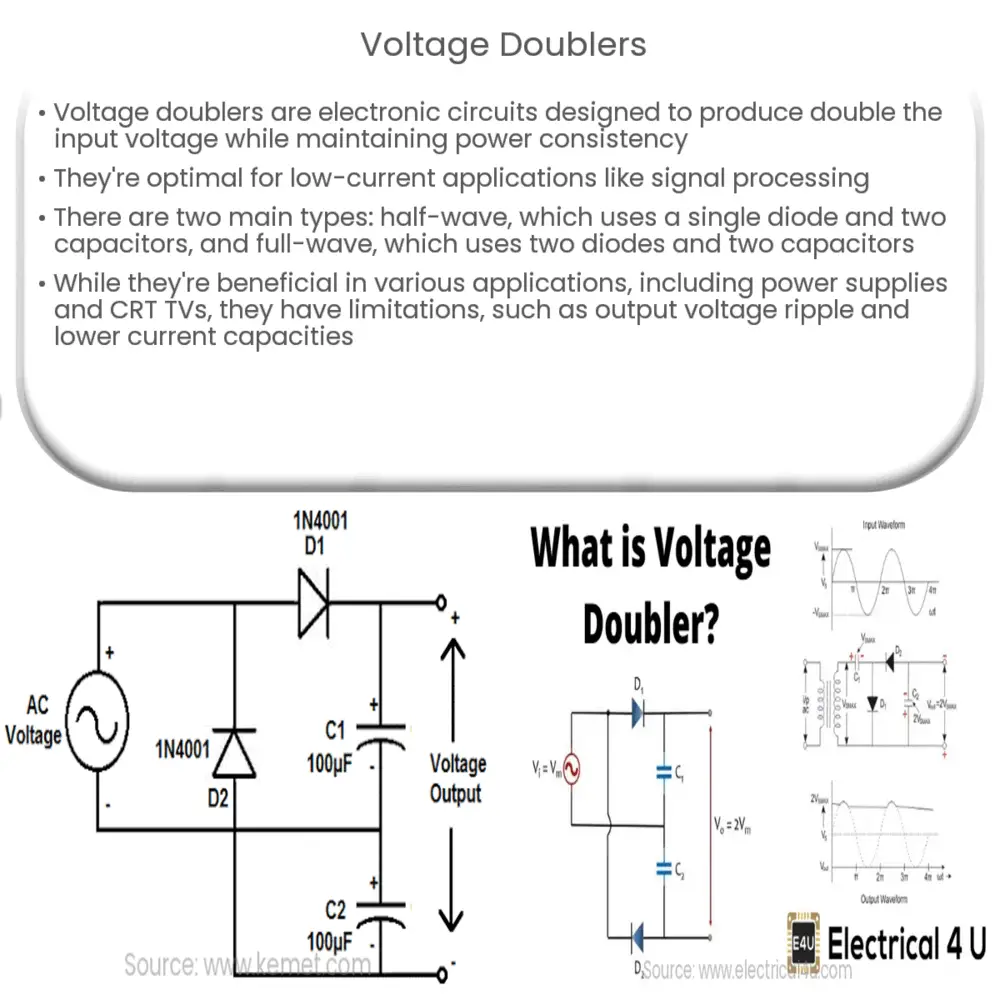Explore the world of voltage doublers, their types, operation, applications, and potential drawbacks in this comprehensive guide.

Voltage Doublers: An Overview
The world of electrical engineering is a vast and complex one, with various components serving critical roles in the operation of electronic devices. One such crucial component is the Voltage Doubler. As the name implies, a voltage doubler is an electronic circuit which is designed to output twice the voltage of its input, all the while ensuring the power remains constant.
These circuits are often used in situations where higher voltage levels are required, but the power source cannot directly provide the desired output. It’s worth noting that voltage doublers are not intended for scenarios requiring a high current output. Instead, they are most effective for low-current applications such as signal processing.
Types of Voltage Doublers
There are primarily two types of voltage doublers, which are differentiated by the technique they use to achieve voltage doubling. These are:
- Half-Wave Voltage Doubler: The half-wave voltage doubler is a type of voltage doubler that uses only one half of an AC cycle. This means it only works when the input waveform is positive or negative, not both. It utilizes a single diode and two capacitors to accomplish this.
- Full-Wave Voltage Doubler: On the other hand, a full-wave voltage doubler operates on both the positive and negative halves of the AC cycle. The operation of a full-wave voltage doubler involves two diodes and two capacitors.
While both of these types of voltage doublers serve the same basic function, the specific usage and implementation often depend on the requirements of the specific electronic device or circuit.
Operation of Voltage Doublers
The fundamental operation of a voltage doubler circuit involves the storage of charge in a capacitor during one half of the AC cycle, and the release of this stored charge to the load during the other half. This operation is achieved through the use of diodes, which ensure that current only flows in one direction. These circuits make use of the peak voltage values rather than the RMS values, and as a result, they are able to deliver an output voltage that is twice the peak input voltage.
Applications of Voltage Doublers
Voltage doublers have a wide range of applications, thanks to their ability to provide higher voltage output from a lower voltage input. Some of these applications include:
- Power Supplies: One of the most common uses of voltage doublers is in power supplies, where they are used to provide higher DC voltage levels.
- Television Sets: In older cathode ray tube (CRT) television sets, voltage doublers were used to generate the high voltage needed for the electron gun.
- Signal Processing: Voltage doublers play a key role in certain signal processing techniques, where they are used to increase the amplitude of a signal.
Potential Drawbacks of Voltage Doublers
Despite their many advantages, voltage doublers also come with a few potential drawbacks. One of the main disadvantages is that they can only provide a doubled voltage at relatively low currents. If a higher current is required, the output voltage will start to drop. Furthermore, voltage doublers produce a DC output that can contain a lot of ripple, especially if the load is relatively heavy. This can lead to unstable operation in certain circuits.
Conclusion
In conclusion, voltage doublers serve an important function in the world of electronics. These devices are capable of delivering double the input voltage, a feature that is particularly useful in a variety of applications from power supplies to television sets. Despite some potential drawbacks such as low current capabilities and output voltage ripple, their benefits often outweigh these considerations, particularly in low-current applications. Therefore, understanding the function and operation of voltage doublers is crucial for anyone involved in the design or repair of electronic devices. Ultimately, voltage doublers remain a vital tool in the electronic engineer’s toolkit, one that contributes greatly to the functionality and efficiency of many electronic devices.

